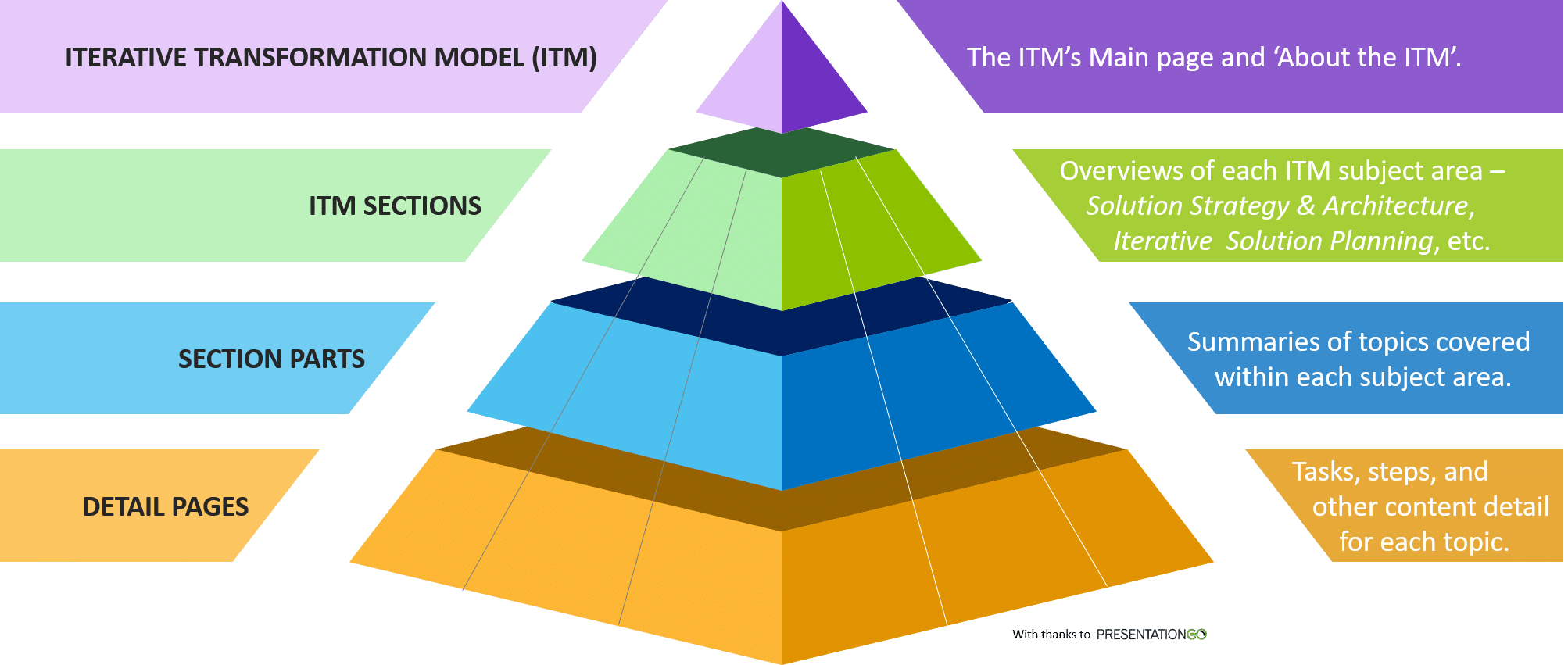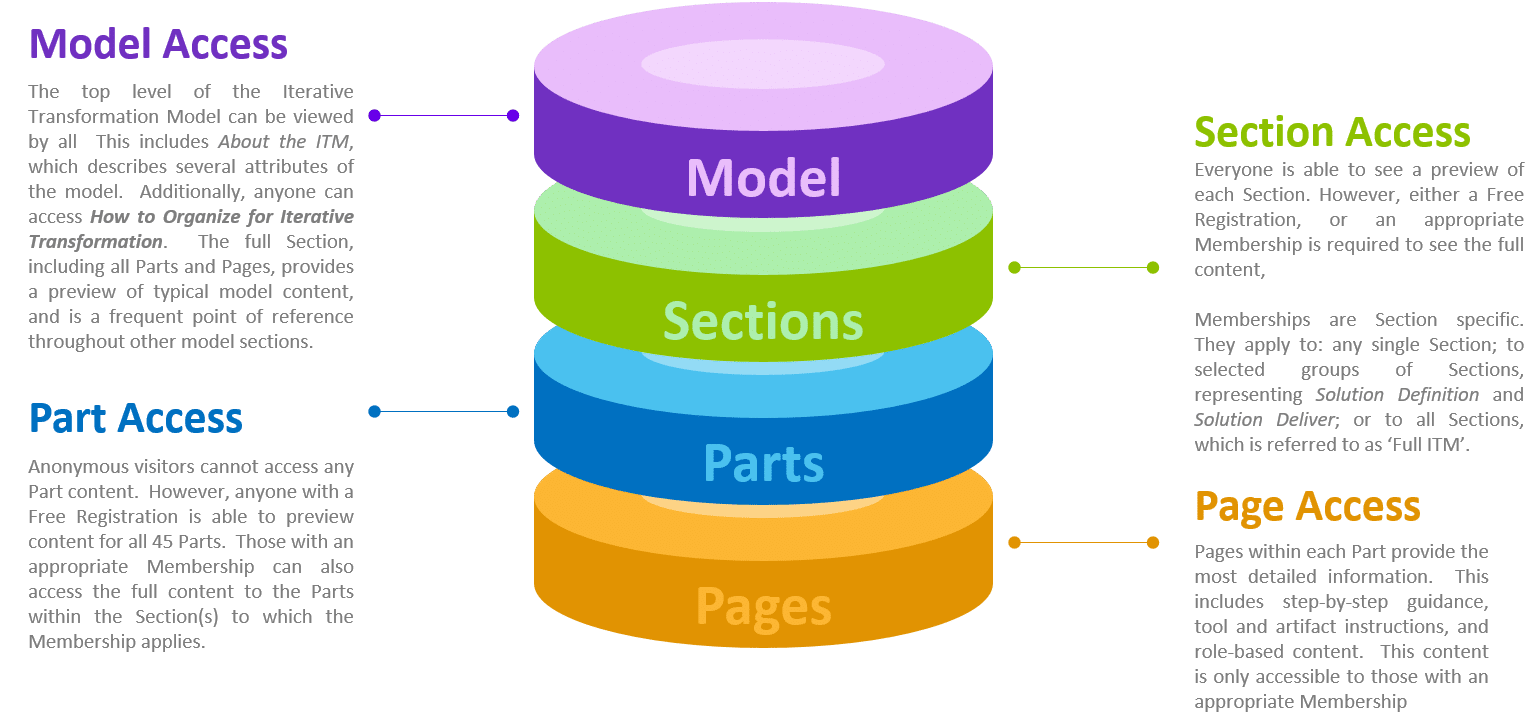The first part of the Model Orientation describes the Model's structure. The structure provides the framework used to organize, and fill in, related Model Content. Content refers to the knowledge capital, experience, guidance, tools and artifacts, the Model provides to improve system implementation.
Let's begin with a simple overview to introduce the levels within the Model, what they're called, and generally what they cover. Next, let's look at controll of model access.
The model is not an all-or-nothing repository. As a matter of fact, it is designed for use in whole, or in part. Specifically, it seeks to provide the right help, to the right people, at the right time.
Multiple Levels for Multiple Audiences

Sections, Parts, and Pages divide the ITM into manageable pieces. These pieces organize its content, and help direct a variety of audiences towards portions relevant to their interests.
In general, Sections address broad subject areas. As such, they assemble knowledge capital and actions related to a portion of any Solution's Lifecycle. A consumers can apply any Section independently. Moreover, consumers can use any combination of Sections to better address broader objectives.
Similarly, Parts organize topics within each subject. Most Parts build upon one another. Frequently, individual Parts define a series of tasks designed to achieve a common Solution definition, or delivery, objective.
Finally, Pages provide the most detailed knowledge and experience. Many describe actions, or step-by-step instructions, for achieving a task. Pages introduce and describe artifacts. They also provide guidance for completing them.
Each Section's intent is to enable relevant participants to deliver more value for less cost. In other words, to achieve levels of productivity that provide faster, and better, results than would be attained otherwise. Each Section applies to a stage in any system's implementation. Iterative transformation executes most stages multiple times over a system's lifecylce.
Use as few Sections as needed. Alternatively, use as many Sections as you like. In other words, use whichever Section(s) can help address areas in which improvement is desired. Generally speaking, use of more Sections will provide better overall results.
How Model Access Works
The Model's design permits multiple people, fulfilling different roles, and with varying perspectives, to quickly, and effectively, work together. For most consumers, there is zero expectation that they need a full understanding of everything in the model.
Rather, most Consumers will have an interest in a single subject area. Perhaps even a single topic within one area. Alternatively, some consumers will have responsibility for coordinating the work of multiple participants, representing a set of related roles. As such, these Consumers will often have an interest in more than one subject area.
Finally, there are a few Consumers who should have an interest in the entire model. Solution Architects should know what all initiative participants are expected to achieve. They should also be able to guide any participant towards achieving their objectives.
Similarly, senior managment involved with Solution Definition and/or Solution Delivery should also have a comprehensive understanding of the work required within each. Further, they should also know what to expect, as well as not to expect, from people fulfilling various roles.

Additionally, anyone representing an Center of Excellence should be familiar with all of the roles, and all of the work exepected from each, to ensure an initiative's success. Finally, anyone who is coaching others, for any iterative delivery role, should be doing so with an understanding of the bigger picture.
The Right Content for the Right Consumers
So, just as there are different areas of Model interest, there are also different paths to access content. For example, the highest, and most general, areas relating to the Model are accessible to all. However, all Sections, and a preview of all Parts, are fully accessible only with a Free Registration. Access to the most detailed knowledge, guides, and step-by-step instructions, are accessible with a Subscription. The various access paths permit use of only the Section(s) needed to support your system implementation.
The How to Organize for Iterative Transformation Section provides an sample of Model content, and is available to all. Take a look.
To continue with the model orientation, look next at Model Content. Otherwise, select the consumer group below which best describes your interest.
